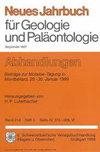The extinct catshark Pachyscyllium distans (Probst, 1879) (Elasmobranchii: Carcharhiniformes) in the Pliocene of the Mediterranean Sea
IF 1
4区 地球科学
Q4 PALEONTOLOGY
Neues Jahrbuch Fur Geologie Und Palaontologie-Abhandlungen
Pub Date : 2020-03-13
DOI:10.1127/njgpa/2020/0877
引用次数: 8
Abstract
Sharks assigned to the carcharhiniform family Scyliorhinidae account for about 160 extant species placed in 18 genera. Most living scyliorhinids are smallto mediumsized ground sharks provided with catlike eyes and nasal barbels similar to whiskers; hence their vernacular name, “catsharks”. Living catsharks mostly inhabit deep or rather deep waters of the warm and temperate seas worldwide, foraging on small fishes and inverterbates. In the present paper, we report on a lateral tooth of Scyliorhinidae collected from a clay pit at Certaldo (central Italy), where marine mudstones belonging to the famously fossiliferous Pliocene successions of Tuscany are exposed. This catshark specimen represents the second bona fide record of the extinct premontreine species Pachyscyllium distans in the Pliocene of the Mediterranean Sea, as well as the geologically youngest confirmed occurrence of this species worldwide. In the Mediterranean Pliocene, P. distans thus coexisted with the similar but distinct species Pachyscyllium dachiardii. After having been widespread in Northern Atlantic, Paratethyan, and Mediterranean waters in Miocene times, P. distans became confined to the Mediterranean Sea during the Pliocene. Therefore, similar to what has recently been suggested for P. dachiardii, we hypothesise that the range of P. distans contracted southward as colder conditions took hold in the Northern Hemisphere. The eventual extinction of P. distans might be related to the first cooling episode that significantly affected the Mediterranean biota around 3 Ma.地中海上新世已灭绝的猫鲨Pachyscyllium distans (Probst, 1879) (elasmobranchia: Carcharhiniformes)
鲨鱼被归为齿形鲨科,在现存的18属中约有160种。大多数现存的鞘鲨是小型到中型的陆地鲨鱼,长着猫一样的眼睛和类似胡须的鼻刺;因此,它们被称为“猫鲨”。现存的猫鲨大多生活在世界范围内温暖和温带海域的深水区,以小鱼和无脊椎动物为食。在本文中,我们报道了从意大利中部Certaldo的一个粘土坑中收集到的一颗Scyliorhinidae的侧齿,该粘土坑是托斯卡纳著名的上新世化石序列的海相泥岩。这个猫鲨标本代表了地中海上新世已经灭绝的前鲑鱼物种Pachyscyllium distans的第二个真实记录,也是该物种在世界范围内地质上最年轻的确认。因此,在地中海上新世,P. distans与相似但不同的物种Pachyscyllium dachiardii共存。在中新世广泛分布于北大西洋、帕拉提提亚和地中海水域之后,P. distans在上新世被限制在地中海。因此,与最近提出的dachiardii疟原虫相似,我们假设随着北半球气候变冷,远距离疟原虫的范围向南缩小。远缘疟原虫的最终灭绝可能与第一次冷却事件有关,该事件对3 Ma左右的地中海生物群产生了重大影响。
本文章由计算机程序翻译,如有差异,请以英文原文为准。
求助全文
约1分钟内获得全文
求助全文
来源期刊
CiteScore
1.70
自引率
25.00%
发文量
65
审稿时长
6-12 weeks
期刊介绍:
Neues Jahrbuch für Geologie und Paläontologie publishes peer-reviewed papers on all fields of palaeontology, sedimentology, stratigraphy, general and applied geology, geodynamics.

 求助内容:
求助内容: 应助结果提醒方式:
应助结果提醒方式:


